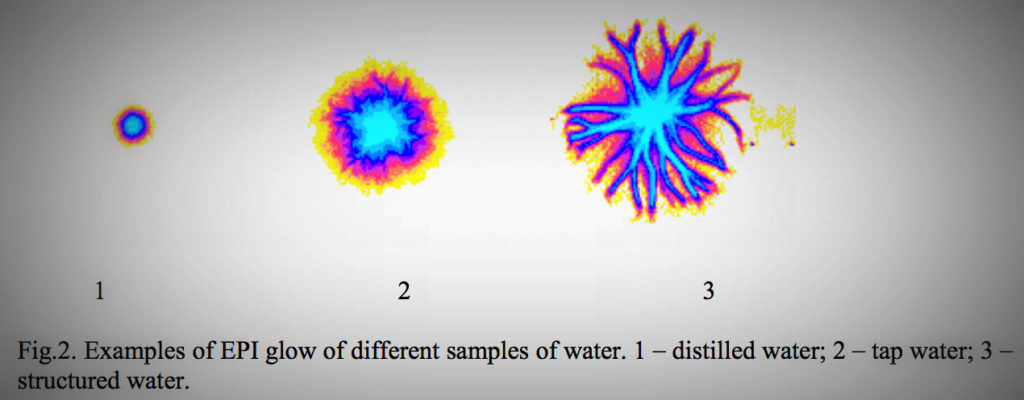пятница, 10 июля 2020 г.
воскресенье, 7 апреля 2019 г.
Rotwein unter Hochspannung
Rotwein unter Hochspannung: Mehrjährige QualitätsUntersuchung
mit Gas-Discharge-Visualisation (GDV)
C.Bigler, D. Levite, M. van der Meer, A. Kaufmann und F.P.Weibel
Keywords: GDV, wine, bio-dynamic, quality, holistic methods
Abstract
We investigated whether we can detect any differences in red wines produced either by bio-dynamic or by standard organic agriculture. We used standard methods to investigate the quality of the wines and Gas-Discharge-Visualisation (GDV) method to investigate a holistic quality of the wines. With the GDV-method, samples are exposed to high voltage. The halo-like gas discharge caused by a burst of electron emission of
the sample is captured by a digital camera underneath a transparent, dielectric surface. The wine samples measured originate from an On-Farm experiment in South of France with two separately managed but neighbouring blocks (same soil and climate conditions): bio-organic and bio-dynamic. Apart from the use of bio-dynamic preparations, plant protection and fertilization was the same in both blocks. The vinification of the sampled grapes was made in two replicates which were analysed separately. During the three years of examination, the bio-dynamic samples did not reveal significant differences when assessed with standard methods (sensory triangle test, polyphenol analysis etc.). However, with GDV measurements the values for the image-parameter “mean intensity” were mostly higher for the wines from biodynamically produced grapes. In a „mixed effect model“ (GDV-parameter „mean intensity“ as dependent variable, replication und cultivation-system as fix and year as random effect) the difference was statistically significant. We conclude that the GDV method has an interesting potential to detect very sensitively differences in food attributes. However, in order to interpret the results in terms of consumer-relevant quality further research is needed.
the sample is captured by a digital camera underneath a transparent, dielectric surface. The wine samples measured originate from an On-Farm experiment in South of France with two separately managed but neighbouring blocks (same soil and climate conditions): bio-organic and bio-dynamic. Apart from the use of bio-dynamic preparations, plant protection and fertilization was the same in both blocks. The vinification of the sampled grapes was made in two replicates which were analysed separately. During the three years of examination, the bio-dynamic samples did not reveal significant differences when assessed with standard methods (sensory triangle test, polyphenol analysis etc.). However, with GDV measurements the values for the image-parameter “mean intensity” were mostly higher for the wines from biodynamically produced grapes. In a „mixed effect model“ (GDV-parameter „mean intensity“ as dependent variable, replication und cultivation-system as fix and year as random effect) the difference was statistically significant. We conclude that the GDV method has an interesting potential to detect very sensitively differences in food attributes. However, in order to interpret the results in terms of consumer-relevant quality further research is needed.
DRINKING WATER QUALITY AND SPORT
COMPARATIVE ASSESSMENT OF THE IMPACT OF DRINKING WATER
QUALITY ON THE ATHLETES’ CONDITION DURING EXERCISE
Gavrilova Е.А.,M.D., Ph.D, Professor. Glushkov S.I., M.D., Ph.D, Professor. Korotkov K.G., Ph.D. Professor. Churganov O.A. Ph.D. Professor. Shelkov O.M. Ph.D. Professor. Logvinov V.S., research associate
Federal State Institution «St. Petersburg Research Institute of Physical Culture and Sport», St. Petersburg, Russia
Key words: grapheme water filter, non-doping methods of improving performance.
Abstract
Integrated studies utilizing methods from physiology, psychophysiology, psychology, and biophysics were conducted. Athletes had the parameters of their condition measured before they began consuming graphene-filtered water as well as after a 30-day period of its consumption during training cycle. The obtained results were compared with the data from a control group of athletes who drank bottled water. It is shown that athletes drinking water passed through a graphene filter experienced growth in aerobic capacity, physical performance, energy potential, and their bodies’ adaptive reserves.
moreCOMPARATIVE ASSESSMENT OF THE IMPACT OF DRINKING WATER
QUALITY ON THE ATHLETES’ CONDITION DURING EXERCISE
ANALYSIS OF STRUCTURED LIQUIDS
ANALYSIS OF STRUCTURED LIQUIDS WITH ELECTROPHOTONIC TECHNIQUE
Korotkov K, Ph.D., Professor, Orlov D.
University of Informational Technologies, Mechanics and Optics, Saint Petersburg, Russia
Key words: structured water, Electrophotonic imaging, Gas Discharge Visualization, high dilutions, consciousness influence
воскресенье, 24 марта 2013 г.
Shungit and water purification
Shungit and water purification The methods of water purification
The most widely spread method of water disinfection is boiling treatment. However, according to the data of the last researches, this longstanding method is not efficient enough. Though boiling really kills bacteria, at the same time it increases the concentration of nitrates, salts and heavy metals. Besides some inorganic compounds contained in the tap water don't dissolve in the course of boiling. It's also important to mention, that in the course of boiling such necessary for the organism biogenous chemical elements contained in the water as calcium, natrium, magnesium, fluorine and others flocculate. Thus the water becomes dead and useless for the organism as it loses the chemical elements of vital importance. This is especially dangerous for children because it influences their growth, proper development and osteogenesis. Bones deformation, tooth decay, osteochondrosis, digestion and blood diseases, the acid-base balance displacement, bronchocele and other health problems can be prevented, if people drink right, life-giving water.
One more quite widely spread method of water disinfection implies usage of chloride that also faces some pitfalls. As it's proved by modern science, chloride is dangerous for people's health as it forms in water so called chloroorganics which are carcinogens.
Usage of home filters is also one of the ways of water purification, but it's not efficient enough either. If the filters are of poor quality, they hardly answer purpose.
One more quite widely spread method of water disinfection implies usage of chloride that also faces some pitfalls. As it's proved by modern science, chloride is dangerous for people's health as it forms in water so called chloroorganics which are carcinogens.
Usage of home filters is also one of the ways of water purification, but it's not efficient enough either. If the filters are of poor quality, they hardly answer purpose.
The history of shungite
The history of shungite usage in Russia
The healing properties of shungite have been known for more than 300 years. The first formal reference to its wonder-making power dates back to early XVII century and is associated with the name of Tsarina Marfa Ioanovna (boyar Xenia Romanova). While being in exile in Tolvuysk Pogost in Zaonezhje (*the region in Karelia on the bank of the Onega Lake) the Grand conventual was hanging between life and death tortured by some kind of epileptic disease. However soon after an unexpected pardon signed by Boris Godunov the local peasants showed her a healing spring of a great wonder-making power where the water is infused on the black stone they had used this water to heal themselves from time immemorial. Thanks to the life-giving water the boyar lady fully recovered from her illness. Soon she gave birth to a baby. Seven children she had given birth to before the exile had died in infancy, while the new-born boy, Mikhail Fyodorovich Romanov, became the founder of a new dynasty which would reign in Russia for 300 years. In memory of boyar Xenia the spring was called “Tsarina’s springâ€, however, it was soon forgotten and only rare inhabitants of the nearby villages used its water.
Shungite Card
Shungite Card

Shungite Card
CEM-CARD with information from Schungite Mine
We have information from the Schungit mine near the village Schunga (Karelia, Russia) stored in a CEM card.
Shungite Card
CEM-CARD with information from Schungite Mine
We have information from the Schungit mine near the village Schunga (Karelia, Russia) stored in a CEM card.
Подписаться на:
Комментарии (Atom)

